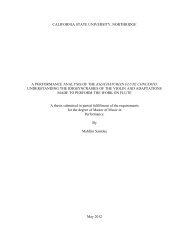Page 1 The California ""- Geographer Annual Publication of the ...
Page 1 The California ""- Geographer Annual Publication of the ...
Page 1 The California ""- Geographer Annual Publication of the ...
Create successful ePaper yourself
Turn your PDF publications into a flip-book with our unique Google optimized e-Paper software.
This is not to say that <strong>the</strong> Koppen classification is <strong>of</strong> higher quality than<br />
certain o<strong>the</strong>r systems, such as that devised by Thornthwaite. 4 However,<br />
<strong>the</strong> ease <strong>of</strong> application <strong>of</strong> basic climatic data to <strong>the</strong> Koppen model and<br />
<strong>the</strong> presentation <strong>of</strong> that data in <strong>the</strong> classified form are outstanding advantages.<br />
Ano<strong>the</strong>r very important benefit that can be noted when certain<br />
modifications <strong>of</strong> <strong>the</strong> Koppen model utilized is that <strong>the</strong>y show a fairly good<br />
climate/vegetation correlation in much <strong>of</strong> <strong>California</strong>. (Many papers,<br />
such as those by Patton and Bailey, have pointed out various discrepancies<br />
in <strong>the</strong> Koppen classification, some <strong>of</strong> which seem to be <strong>the</strong> result <strong>of</strong> translation<br />
difficulties. 5)<br />
<strong>The</strong> usefulness <strong>of</strong> <strong>the</strong> accompanying map (Figure I. See map at end<br />
<strong>of</strong> article.) lies not so much in <strong>the</strong> classification technique, hut more in <strong>the</strong><br />
use <strong>of</strong> data from over 1,000 climatic stations in <strong>California</strong> and adjacent<br />
areas <strong>of</strong> Oregon, Nevada and Arizona. This is many times <strong>the</strong> number <strong>of</strong><br />
stations used in previous maps <strong>of</strong> this kind for this area and allows a<br />
more detailed analysis <strong>of</strong> <strong>California</strong>'s climates. All <strong>of</strong> <strong>the</strong> climatic stations<br />
do not appear on <strong>the</strong> base map (nor are <strong>the</strong>y plotted on Figure 3) due<br />
to space limitations. However, a few <strong>of</strong> <strong>the</strong> key sites are noted. All <strong>of</strong> <strong>the</strong><br />
data utilized in preparing <strong>the</strong> climatic map were obtained from <strong>the</strong><br />
<strong>California</strong> Department <strong>of</strong> Water Resources in Sacramento. It represents<br />
data from stations operated by <strong>the</strong> <strong>California</strong> Department <strong>of</strong> Water<br />
Resources cooperative stations, and United States Wea<strong>the</strong>r Bureau<br />
<strong>of</strong>ficial and cooperative climatic stations. (Table 7 is a more detailed<br />
description <strong>of</strong> <strong>the</strong> legend shown in Figure I.)<br />
METHOD<br />
In order to insure a fairly uniform base period for <strong>the</strong> climatic data<br />
used in preparation <strong>of</strong> Figure 1 <strong>the</strong> precipitation means were based<br />
on <strong>the</strong> 50-season period 1904-05 through 1954-556 and temperature means<br />
were generally based on <strong>the</strong> 22-year period 1931 through 1952. <strong>The</strong> length<br />
<strong>of</strong> record at <strong>the</strong> climatic stations varied from approximately five years at a<br />
few places to over 100 years in some instances. If a precipitation station<br />
had a shorter record than <strong>the</strong> length <strong>of</strong> <strong>the</strong> base period <strong>the</strong> record was extended<br />
by double-mass comparison with nearby longer-term stations that<br />
4 C. 'iV. Thornthwaite, "<strong>The</strong> Climate <strong>of</strong> North America According to a New<br />
Classification," Geographical Review, Vol. 24 (October 1931), pp. 633-655; and<br />
C. W. Thornthwaite, "An Approach Toward A Rational Classification <strong>of</strong> Climate,"<br />
Geographical Review, Vol. 38 (1948), pp. 658-672; and a publication containing<br />
some modifications <strong>of</strong> <strong>the</strong> 1948 Thornthwaite classification. .<br />
5 Clyde P. Patton, "A Note on <strong>the</strong> Classification <strong>of</strong> Dry Climates in <strong>the</strong> Koppen<br />
System," <strong>The</strong> <strong>California</strong> Geogmpher, Vol.. 3 (1962), pp. 105-112; and Harry P.<br />
Bailey, "Some Remarks on Koppen's Definitions <strong>of</strong> Climatic Types and <strong>The</strong>ir Mapped<br />
Representations," Geographical Ret•iew, Vol. 52 (1962), pp. 444-447.<br />
6 Referring to <strong>the</strong> "precipitation season," which is <strong>the</strong> 12-month period from<br />
July I through June 31. Because <strong>of</strong> <strong>the</strong> nature and <strong>the</strong> timing <strong>of</strong> Mediterranean type<br />
precipitation <strong>the</strong> cool season is also <strong>the</strong> wet season, which happens to fall into two calendar<br />
years. Thus, in speaking <strong>of</strong> <strong>the</strong> year's precipitation it would seem inappropriate<br />
to divide December <strong>of</strong> one year from January <strong>of</strong> <strong>the</strong> next merely because <strong>the</strong> calendar<br />
must be changed. This is also <strong>the</strong> feeling <strong>of</strong> most state agencies that deal with precipitation<br />
data in <strong>California</strong>.<br />
2













